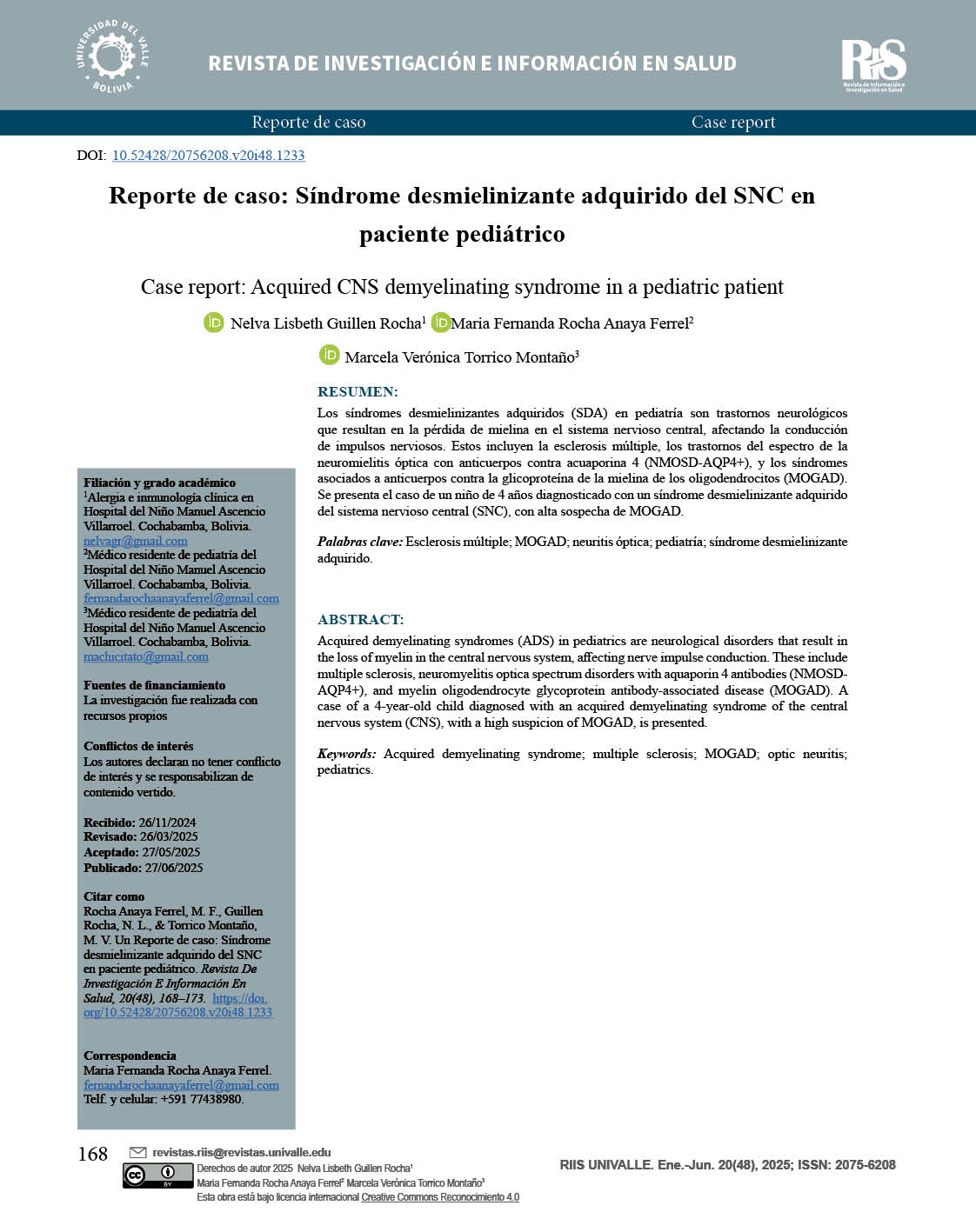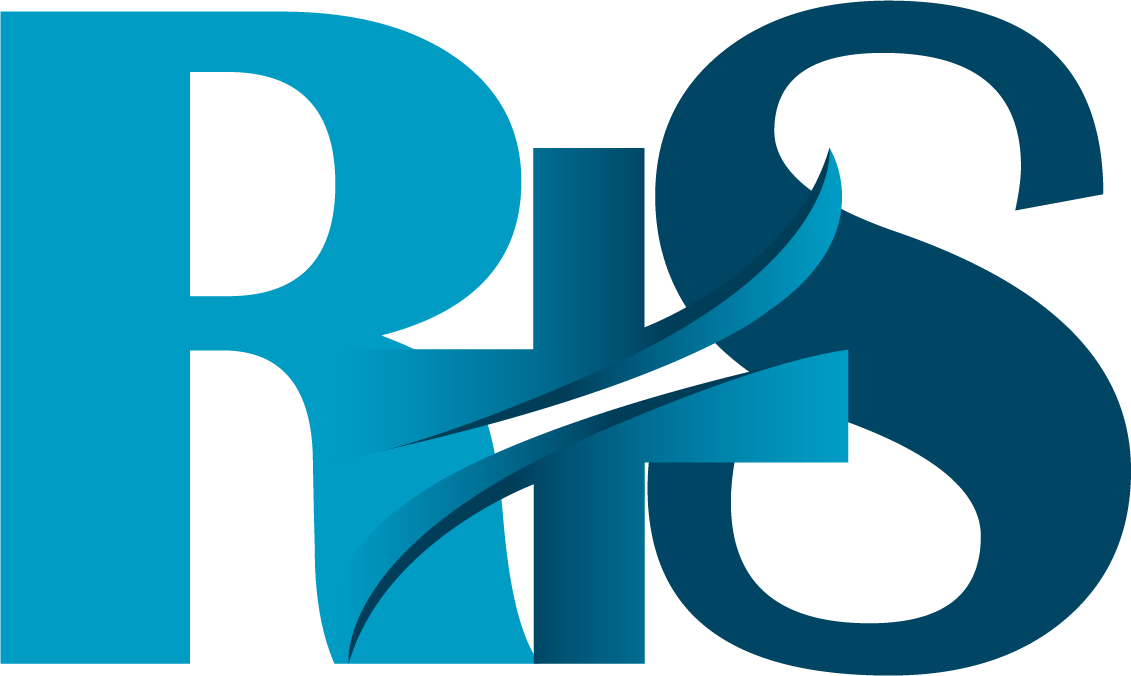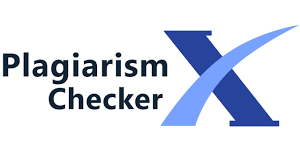Case report: Acquired CNS demyelinating syndrome in a pediatric patient
DOI:
https://doi.org/10.52428/20756208.v20i48.1233Keywords:
Síndorme desmielinizante Adquirido, Pediatría, Esclerosis Múltiple, Neuritis Óptica, MOGADAbstract
Acquired demyelinating syndromes (ADS) in pediatrics are neurological disorders that result in the loss of myelin in the central nervous system, affecting nerve impulse conduction. These include multiple sclerosis, neuromyelitis optica spectrum disorders with aquaporin 4 antibodies (NMOSD-AQP4+), and myelin oligodendrocyte glycoprotein antibody-associated disease (MOGAD). A case of a 4-year-old child diagnosed with an acquired demyelinating syndrome of the central nervous system (CNS), with a high suspicion of MOGAD, is presented.
Downloads
References
G. Olivé-Cirera y T. Armangué, «Primer episodio de enfermedad desmielinizante en la edad pediátrica,» Protoc diagn ter pediatr, vol. 1, [Internet] pp. 243-254, 2022. [consultado el 17 de marzo de 2025]. Disponible en: https://www.aeped.es/sites/default/files/documentos/25_0.pdf
R. Pérez, «Esclerosis múltiple pediátrica: avances en el diagnóstico y tratamiento,» Neurol Clin, vol. 10, n.º 10, pp. 260-267, 2019.
I. V. Carvalho, C. S. Dos Santos, J. Amaral, J. A. Ribeiro, C. Pereira, R. P. Pais et al., «Esclerosis múltiple en menores de diez años: el reto de un diagnóstico poco frecuente en una población especial: una serie de casos,» Front Neurosci, vol. 17, [Internet] 2023. [consultado el 10 de mayo de 2025]
Disponible en: http://dx.doi.org/10.3389/fnins.2023.1297171
https://doi.org/10.3389/fnins.2023.1297171
PMid:38174051 PMCid:PMC10761493
B. Nikolić, N. Ivančević, I. Zaletel, B. Rovčanin, J. Samardžić y J. Jančić, «Characteristics of pediatric multiple sclerosis: A tertiary referral center study,» PLoS One, vol. 15, [Internet] n.º 12, 2020. [consultado el 09 de enero de 2025]. Disponible en: https://doi.org/10.1371/journal.pone.0243031
https://doi.org/10.1371/journal.pone.0243031
PMid:33264341 PMCid:PMC7710048
R. Suntornlohanakul y E. A. Yeh, «Optimizing Drug Selection in Children with Multiple Sclerosis: What Do We Know and What Remains Unanswered? » Paediatr Drugs, [Internet] vol. 27, n.º 2, pp. 161-179, 2025. [consultado el 09 de enero de 2025]. Disponible en: https://doi.org/10.1007/s40272-024-00675-1
https://doi.org/10.1007/s40272-024-00675-1
PMid:39724509
D. Jakimovski, S. Awan, S. P. Eckert, O. Farooq y B. Weinstock-Guttman, «Multiple Sclerosis in Children: Differential Diagnosis, Prognosis, and Disease-Modifying Treatment» CNS Drugs, [Internet]. vol. 36, n.º 1, pp. 45-59, 2022. [consultado el 09 de enero de 2025]. Disponible en: https://doi.org/10.1007/s40263-021-00887-w
https://doi.org/10.1007/s40263-021-00887-w
PMid:34940954 PMCid:PMC8697541
A. P. J. Rodríguez y M. D. Díaz, «Neuromielitis óptica asociada a anticuerpos contra acuaporina 4: diagnóstico y manejo en pediatría,» Rev Neurol Pediátrica, vol. 14, n.º 3, pp. 180-189, 2019.
S. Nishiyama, J. M. Seok, A. E. Wright, I. Lotan, T. Mikami, N. C. Drosu et al., «Anti-aquaporin-4 immune complex stimulates complement-dependent Th17 cytokine release in neuromyelitis optica spectrum disorders» Sci Rep, [Internet] vol. 14, n. º 1 ,2024. [consultado el 09 de enero de 2025]. Disponible en: https://doi.org/10.1038/s41598-024-53661-5
https://doi.org/10.1038/s41598-024-53661-5
PMid:38326464 PMCid:PMC10850367
D. L. Mora Cuervo, G. Hansel y D. K. Sato, «Immunobiology of neuromyelitis optica spectrum disorders » Curr Opin Neurobiol, [Internet]. vol. 76, 2022. [consultado el 09 de enero de 2025]. Disponible en: https://doi.org/10.1016/j.conb.2022.102618
https://doi.org/10.1016/j.conb.2022.102618
PMid:35973380
L. G. Fernández y L. M. Martínez, «Síndromes asociados a anticuerpos contra la glicoproteína de la mielina de los oligodendrocitos: una revisión clínica,» Acta Neurol Esp, vol. 23, n.º 2, pp. 112-120, 2021.
B. Banwell, J. L. Bennett, R. Marignier, H. J. Kim, F. Brilot, E. P. Flanagan et al., «Diagnosis of myelin oligodendrocyte glycoprotein antibody-associated disease: International MOGAD Panel proposed criteria» Lancet Neurol, [Internet] vol. 22, n.º 3, pp. 268-282, 2023. [consultado el 10 de junio de 2025]. Disponible en: https://doi.org/10.1016/s1474-4422(22)00431-8
https://doi.org/10.1016/S1474-4422(22)00431-8
PMid:36706773
W. Ambrosius, S. Michalak, W. Kozubski y A. Kalinowska, «Myelin Oligodendrocyte Glycoprotein Antibody-Associated Disease: Current Insights into the Disease Pathophysiology, Diagnosis and Management» Int J Mol Sci, [Internet] vol. 22, n. º 1, p. 100, 2020. [consultado el 10 de junio de 2025]. Disponible en: https://doi.org/10.3390/ijms22010100
https://doi.org/10.3390/ijms22010100
PMid:33374173 PMCid:PMC7795410
W. Zeng, L. Yu, J. Wu, F. Wang, X. Liu, S. Ren et al., «Clinical characteristics and long-term follow-up outcomes of myelin oligodendrocyte glycoprotein antibody-associated disease in Han Chinese participants» Medicine (Baltimore), [Internet] vol. 102, n. º 40, 2023. [consultado el 10 de junio de 2025]. Disponible en: https://doi.org/10.1097/md.0000000000035391
https://doi.org/10.1097/MD.0000000000035391
PMid:37800805 PMCid:PMC10553075

Downloads
Published
How to Cite
Issue
Section
License
Copyright (c) 2025 María Fernanda Rocha Anaya Ferrel, Nelva Lizbeth Guillen Rocha, Marcela Verónica Torrico Montaño

This work is licensed under a Creative Commons Attribution 4.0 International License.
Authors who publish with this journal agree to the following terms:
- Authors retain copyright and grant the journal right of first publication with the work simultaneously licensed under a Creative Commons Attribution License 4.0 that allows others to share the work with an acknowledgement of the work's authorship and initial publication in this journal.
- Authors are able to enter into separate, additional contractual arrangements for the non-exclusive distribution of the journal's published version of the work (e.g., post it to an institutional repository or publish it in a book), with an acknowledgement of its initial publication in this journal.
- Authors are permitted and encouraged to post their work online (e.g., in institutional repositories or on their website) prior to and during the submission process, as it can lead to productive exchanges, as well as earlier and greater citation of published work.






















